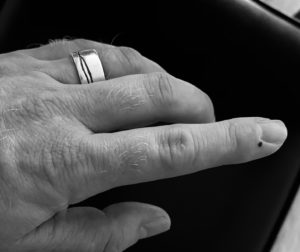In the first part of this post on the Large Intestine organ system, we discussed some basic information including: the name and official related to LI, the five element and six conformation designation and more. In this post, I’d like to dig a little deeper into the symbolism of this important organ system. In particular, I’d like to reflect on the way that the Large Intestine organ system, similar to its Metal partner the Lung, creates a conversation about purity and impurity in the body.
Hexagram 34 – Da Zhuang 大壯
Translator Stephen Karcher interprets the name of this hexagram as “Invigorating Strength” in his Total I Ching, others call it variously Great invigoration or Great strength and of course many other translations exist. I think that Karcher puts it well when he interprets the text as indicating,
“The way to deal with it is to focus your strength through a central creative idea. Putting your ideas to the trial will bring profit and insight. Beware of hurting others through excessive use of force” (Karcher 271).
This is, in a way, a perfect encapsulation of all that I talked about in the previous article! In the energy of Large intestine, we have great capacity to focus (transmit the Dao, give birth, get things done – just PUSH) and the danger for that focus and force to turn destructive (the Dictator, great fevers). On a more psychological level, Large Intestine energy gives us the ability to focus our power on a single point and move through any difficulty until our deed is done. This is a great skill, regardless of where it is utilized.
The more esoteric factors come in when we consider the trigrams that compose this hexagram
The combination of Wood over Metal, Thunder over Heaven creates a situation of invigoration, movement, excitement and – ultimately – new beginnings. We must clean out the old to bring in the new, and the force that allows us to do this must be up to the task. Heiner Fruehauf would often talk about the Large Intestine as being the purest of the organ systems, because it has to deal with the least pure of substances – it requires great purity to maintain deep purity for the body. We can think about the use of colonics on a base level to represent the essence of this ideal – keep the colon clean and free flowing and your body can detoxify.
More about Metal
 Metal has many characteristics and associations that resonate with what we’ve discussed about Large Intestine. The color of Metal is white. White is just the reflection of all color back to the observer – nothing “sticking” to the object. This reflective quality makes some think of purity, and you’ll find many cultures that equate light/white with divinity or purity. There are, of course, obvious potential connections here with the scourge of white supremacy and various types of unjust hierarchies being based on lightness versus darkness – a topic I hope to explore here in the future.
Metal has many characteristics and associations that resonate with what we’ve discussed about Large Intestine. The color of Metal is white. White is just the reflection of all color back to the observer – nothing “sticking” to the object. This reflective quality makes some think of purity, and you’ll find many cultures that equate light/white with divinity or purity. There are, of course, obvious potential connections here with the scourge of white supremacy and various types of unjust hierarchies being based on lightness versus darkness – a topic I hope to explore here in the future.
We associate the pungent aroma with metal – which I always associate with much incense. Incense and other pungent things can be used to open the mind, to communicate with Spirit. All of these upward, brilliant, pure things infuse the Large Intestine with the ability to deal with impurity – the ability to “transmit the Dao/way” and to create “change and transformation.” Pungency as a concept is complex, as the word “pungent” evokes different things based on your culture, culinary history and prior use of the word. It’s probably not the best translation of the Chinese term.
Importantly, the Yin emotion most often associated with Metal is sadness or grief.
When people have a great injury to a Metal organ system, they have a tendency to stay in grief, to not let go. This is a malfunction, in a way, of the descending quality of Metal. You are unable to let things fall where they may. On the other hand, we can think of it as becoming dragged down in the filth, unable to let the filthy things leave our view but instead stay there creating toxicity. Of course it is normal to have sadness when a sad event has occurred – but the tendency to hang on to these things is never healthy. We must learn to let go of the things that are ready to pass (Large Intestine) and take in the freshness of the new world we are privileged to live in (Lung).
Large Intestine 1 – 商陽, shāng yáng
 To show how this can manifest on a very specific practical level, consider the metal point on the Large Intestine channel – LI1, the Jing-well point of the Large Intestine channel. As many Jing-well points, LI-1 is excellent at clearing acute accumulations of heat, but on the Yangming Large Intestine channel, perhaps this effect is even more emphasized. Its use in descending the fire in cases of high fever certainly resonate with what we’ve been discussing so far. It is also known for its ability to descend Qi stagnation in the chest through its connection to the Lung – again we see use of the physiological descending property of the Large Intestine. Some Worsley-style five element acupuncturists use this point to descend mental stagnation, encouraging the patient to “let go” of old emotions that no longer serve. Certainly the rest of us could learn something from this usage.
To show how this can manifest on a very specific practical level, consider the metal point on the Large Intestine channel – LI1, the Jing-well point of the Large Intestine channel. As many Jing-well points, LI-1 is excellent at clearing acute accumulations of heat, but on the Yangming Large Intestine channel, perhaps this effect is even more emphasized. Its use in descending the fire in cases of high fever certainly resonate with what we’ve been discussing so far. It is also known for its ability to descend Qi stagnation in the chest through its connection to the Lung – again we see use of the physiological descending property of the Large Intestine. Some Worsley-style five element acupuncturists use this point to descend mental stagnation, encouraging the patient to “let go” of old emotions that no longer serve. Certainly the rest of us could learn something from this usage.
I will end this article here, though clearly there is much more to say. I’ve only provided a brief glimpse into the symbolism of this mediator of the pure and impure. I’m interested to hear comments from readers – how does this resonate with your picture of Large Intestine and how does it clash? Can you see any practical benefits to working with this kind of information?
[This post has been updated during the 2020 site updates. My goal during post updates was to keep the character of the original post, but update for corrections and clarity, as well as to remove broken links.]

[…] and Large Intestine symbolism is very helpful when thinking through issues of acupuncture business finance. Finding new streams […]